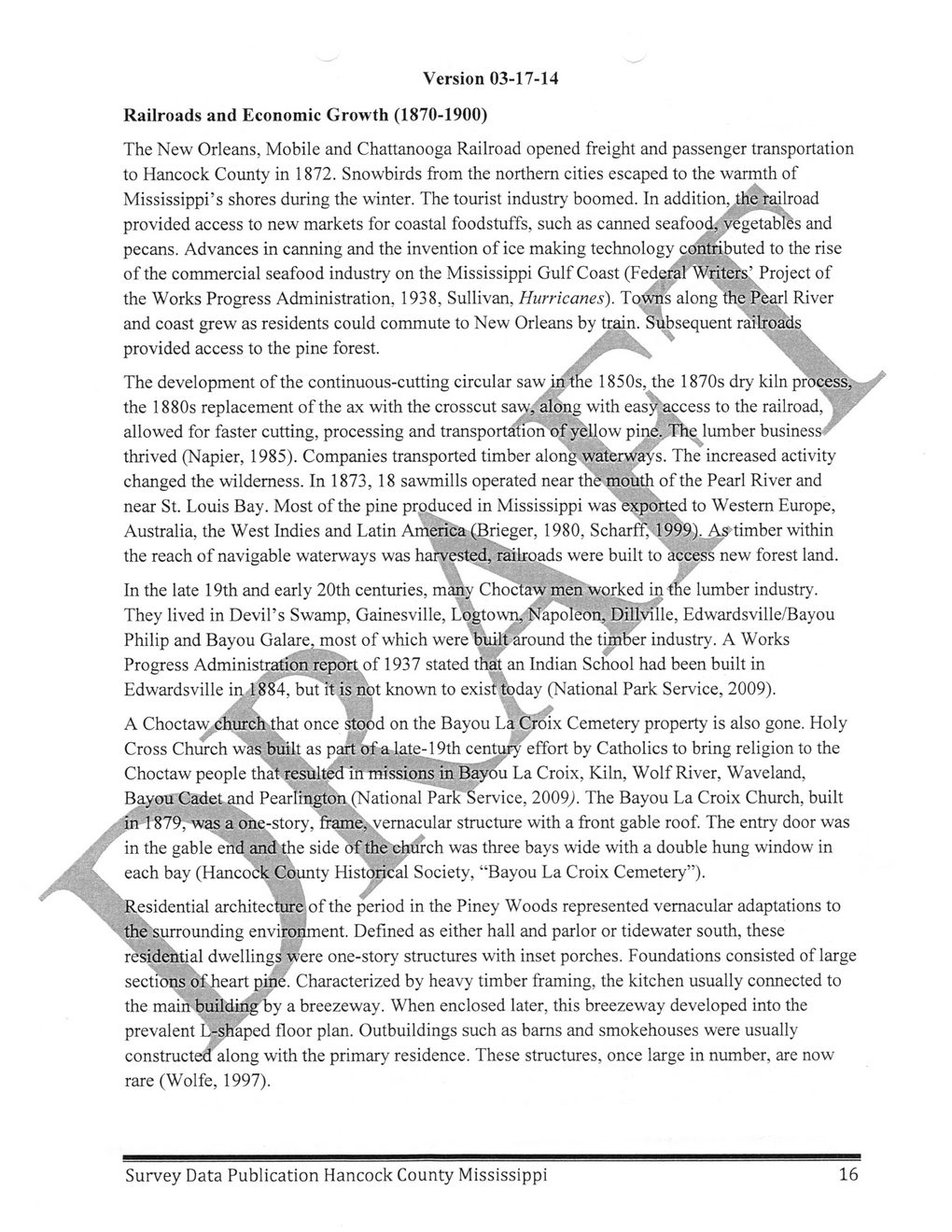This text was obtained via automated optical character recognition.
It has not been edited and may therefore contain several errors.
Version 03-17-14 Railroads and Economic Growth (1870-1900) The New Orleans, Mobile and Chattanooga Railroad opened freight and passenger transportation to Hancock County in 1872. Snowbirds from the northern cities escaped to the warmth of Mississippi’s shores during the winter. The tourist industry boomed. In addition, .the railroad provided access to new markets for coastal foodstuffs, such as canned seafood, vegetables and pecans. Advances in canning and the invention of ice making technology contributed to the rise of the commercial seafood industry on the Mississippi Gulf Coast (FederalWriters’ Project of the Works Progress Administration, 1938, Sullivan, Hurricanes). Towns along the Pearl River and coast grew as residents could commute to New Orleans by train. Subsequent railroads provided access to the pine forest. , ^...•'>. The development of the continuous-cutting circular saw in tlae 1850s, the 1870s dry kiln process, the 1880s replacement of the ax with the crosscut saw,'alcing with easy access to the railroad, , allowed for faster cutting, processing and transportation of yellow pine.. The lumber business thrived (Napier, 1985). Companies transported timber along waterways. The increased activity changed the wilderness. In 1873, 18 sawmills operated near the mouth of the Pearl River and near St. Louis Bay. Most of the pine produced in Mississippi was exported to Western Europe, Australia, the West Indies and Latin America (Brieger, 1980, Scharff, 1999). As timber within the reach of navigable waterways was harvested, railroads were built to access new forest land. In the late 19th and early 20th centuries, many Choctaw men worked in the lumber industry. They lived in Devil’s Swamp, Gainesville, Logtown, Napoleon, Dillville, Edwardsville/Bayou Philip and Bayou Galare, most of which were built around the timber industry. A Works Progress Administration report of 1937 stated that an Indian School had been built in Edwardsville in 1884, but it is not known to exist today (National Park Service, 2009). A Choctaw church that once stood on the Bayou La Croix Cemetery property is also gone. Holy Cross Church was built as part of a late-19th century effort by Catholics to bring religion to the Choctaw people that resulted in missions in Bayo'u La Croix, Kiln, Wolf River, Waveland, Bayou Cadet and Pearlington ^(National Park Service, 2009/ The Bayou La Croix Church, built in 1879, was a one-story, frame, yemacular structure with a front gable roof. The entry door was in the gable end and the side of the church was three bays wide with a double hung window in each bay (Hancock County Historical Society, “Bayou La Croix Cemetery”). Residential architecture'of the period in the Piney Woods represented vernacular adaptations to the surrounding environment. Defined as either hall and parlor or tidewater south, these residential dwellings were one-story structures with inset porches. Foundations consisted of large sections of heart pine. Characterized by heavy timber framing, the kitchen usually connected to the main building by a breezeway. When enclosed later, this breezeway developed into the prevalent L-shaped floor plan. Outbuildings such as bams and smokehouses were usually constructed along with the primary residence. These structures, once large in number, are now rare (Wolfe, 1997). Survey Data Publication Hancock County Mississippi 16

Hancock County History and Archeology Survey-Publication-Data-2014-(18)